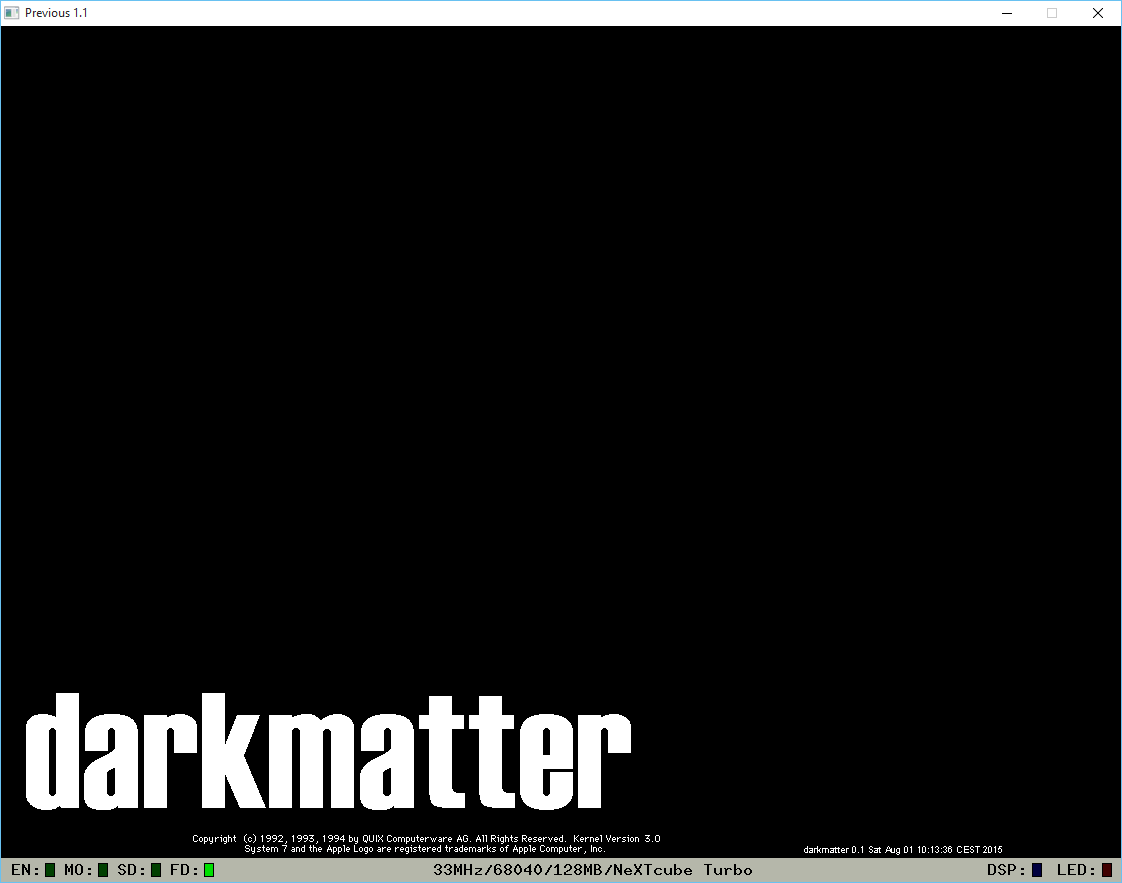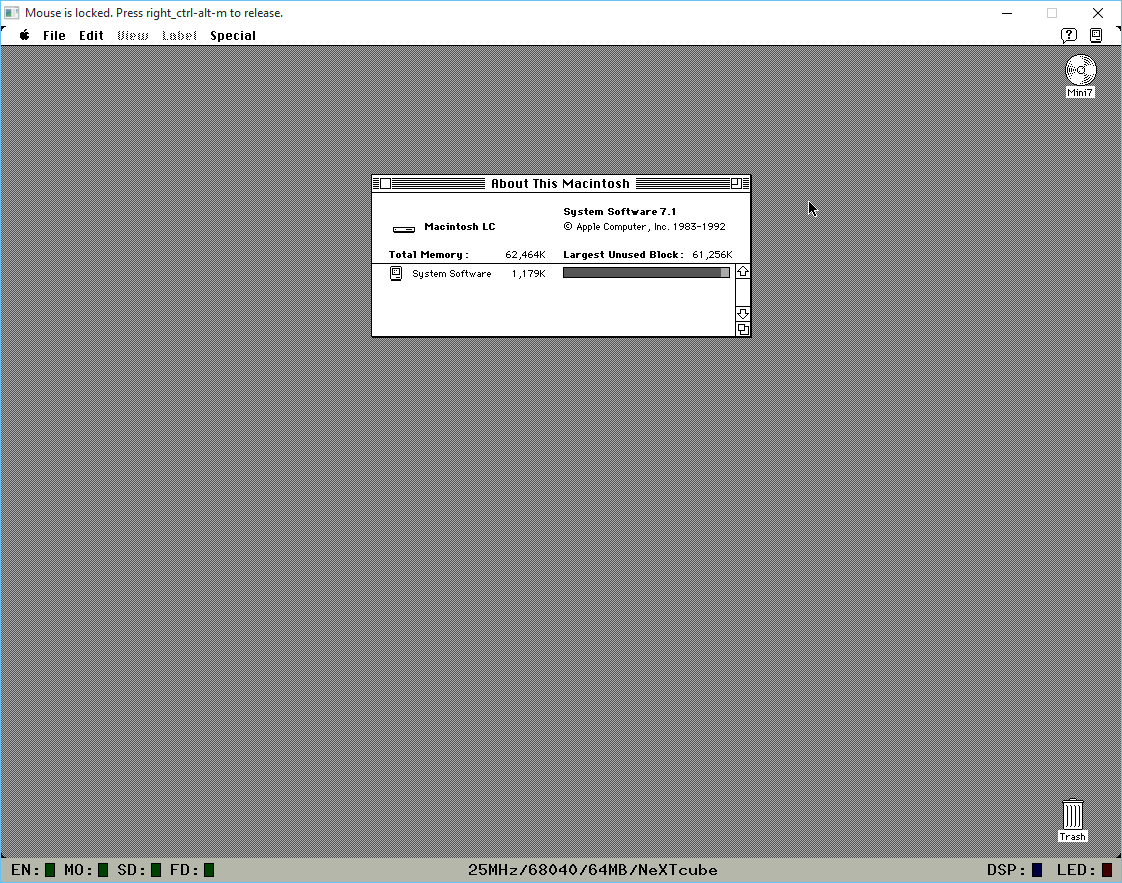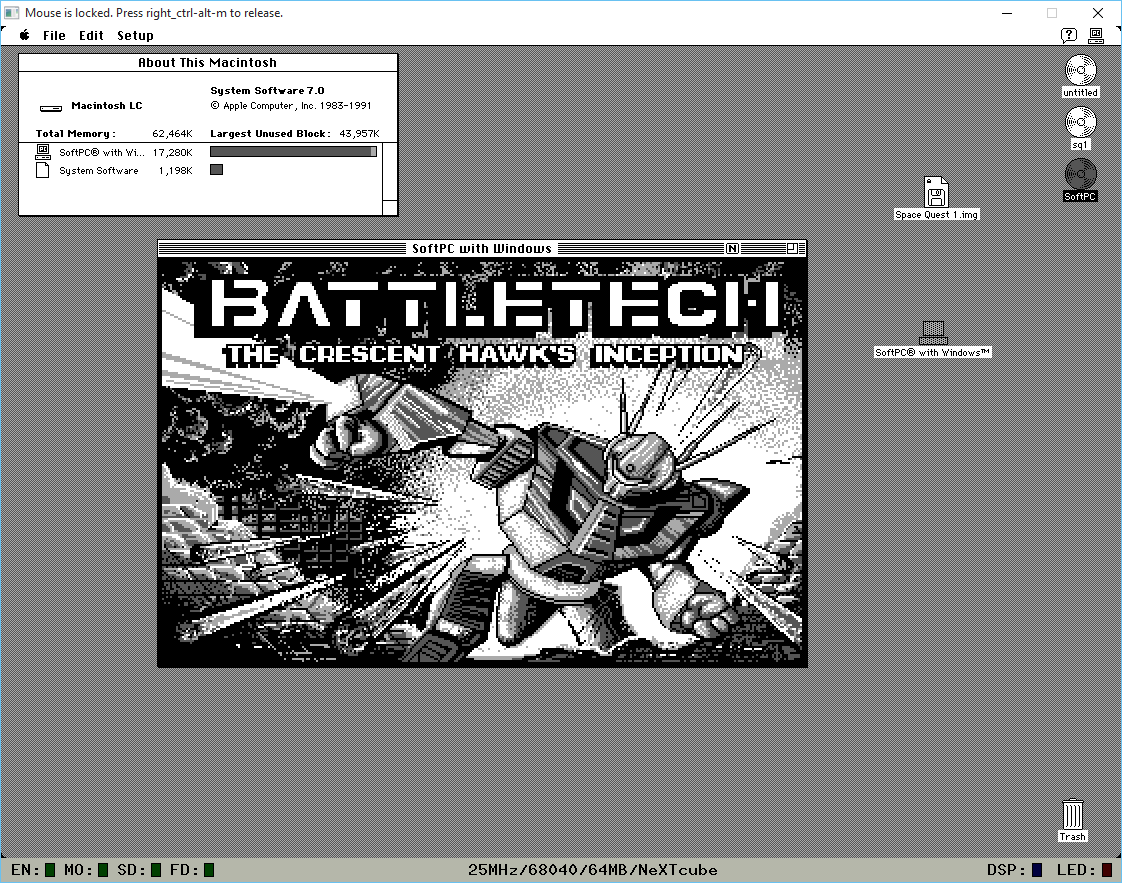The NeXT community has been about this old Mac emulator, daydream making a comeback onto NeXT hardware. Â Branded as darkmatter it runs on the bare metal of the NeXT cube/stations and can run MacOS in much the same way that Basilisk II does.
What makes this interesting is that the 68040 is cycle set, and uses a much more mature CPU emulation core than Basilisk II, so it should give more accurate emulation. However it will run at 68040 25Mhz speeds, so it won’t win any speed records.
Naturally programs (Space Quest I) that blit directly to the display probably expect Mac/Plus/Se dimensions so the NeXT display won’t be ideal. Â But good old SoftPC for MacOS runs great!
And again, being set to 68040 speeds, it’s nowhere near as turbo as Basilisk II/SheepShaver.
For anyone interested, you’ll want Previous, the latest build and a test disk. Â Set the emulation for either a NeXT Computer (68030), or NeXTcube (68040), add the test disk as SCSI disk 0, and either type in ‘bsd’ at the firmware prompt, or have it automatically boot in the options.




Just read through that thread. They had one of the original developers basically patch the product for them to read the ROM from disk. Super neat!
The mention of a PPC version for PReP systems is rather interesting (if ultimately futile). It does seem like everyone was always waiting for a killer app the PPC; be it OS/2 or apparently MacOS, but other than NT, it never really happened.
While down the RISC path; I’ll forever wonder what could have been with Alpha if HP hadn’t bought Compaq/DEC; would the platform have continued (ie would MS have continued supporting it), or would AMD64 inevitably kill it?
Well the problem with the Alpha was all the good boards were going to be DEC OEM’d. You couldn’t get an 8 way Alpha system without going through DEC. They started to loosen their grip a little bit towards the end, but the problem was as always that Intel was 1-2 years behind them, and they were 5x-20x the price. If you needed the speed TODAY and had the cash ( like one website I saw using a big MSSQL 7 install on the Alpha that featured a certain Star Trek personage) it was great but quickly obsoleted hardware.
There is no doubt that once Compaq bought DEC the Alpha was cooked, as Compaq sold a lot of enterprise kit to people phasing out expensive Alphas, and they wanted to be #1 in that space, not being the follow up act to the Alpha. And for what it’s worth, Compaq killed the Alpha first, Microsoft killed it a week later. But doing a port from MS’s POV without OEM involvement isn’t worth their time.
Intel was going their own way with the much delayed, and balyhoo’d Itanium which in the end was a colossal waste of time and money.
Ultimately why AMD64 killed everyone is that it runs i386 code at full speed. It’s that simple, if the Itanium could have run i386 code at an acceptable speed, there was some hope for it in the Wintel world. Heck even DELL made Itanium gear. !FX32 really set the bar for new processors in that they have to be able to run x86 code reasonably well or they will die. It’s the #1 reason why the MIPS and PowerPC went nowhere.
The PowerPC was botched from everywhich angle of pie in the sky dreams from everyone who hated MS/Intel but all they did was blow through cash on more dreams (talgent/pink/OS2/Solaris/NT) and really have nothing to show for it, but a cheaper part cost RS/6000.
Motorola really screwed up with the 88000 line. Funny enough in the early Darwin source, there is even mention of a 98000 processor. And an aborted attempt at the i860 as well (the original RISC target for Windows NT).
Pretty much all the RISC dreams turned into vapour. In much the same way that microkernels died on the vine.
That’s an interesting take on it. In my (rather uninformed) view, I had simply pinned the mass-extinction of all the interesting, promising architectures solely on Itanium.. what with Intel announcing it super-early and promising the world with all the advances it guaranteed (in part by compiler technology that would later be shown to be impossible).
If I’m reading it right, PA-RISC, MIPS (SGI), and Alpha were all dropped in favor of the picture that Intel painted with Itanium. HP stuck with it, and SGI died long ago as gaming graphics quickly caught up with and surpassed them.
SPARC is still around but Oracle doesn’t put them in workstations anymore. RISC is still going strong in the devices market. And the rest of us are stuck with x86, which is a damn shame.
I’ve seen and played with MIPS (SGI), Sparc, PowerPC (obviously the Macs and an IBM server) and Alpha boxes, but have never actually seen an Itanium box in the wild.
I remember reading about it plenty; but the impression I had from most publications of the era wasn’t overly positive – lot’s of hype yes, but it all very quickly died once people had them. The high cost, poor yeilds (at least in the initial run), super slow x86 emulation and (again at least at the time) terrible software support.
Then it wasn’t long before the Opterons came along; I don’t recall hearing a single negative thing about them. Hell Sun were building servers around them by the end!
It won’t boot it says sdmach not found on both bsd and boot to hdd
hmmm try:
bsd(0,0,0)daydream
I may have to redo them. sigh.
Also it won’t even boot NeXTSTEP 3.3 it just stops at a broken loading circle
Hey! It worked……………Not really it justs get stuck to the Darkmatter splash screen
the daydream emulator uses an external device which contains the roms for the mac, you need to dump the roms to a file fist
The author of daydream contributed updates that no longer require the dongal, and various enhancements
*first
Does the disk image work? And with what version of previous?
It doesn’t really boot. Here’s the errors it gives out.
http://doimeabarri.ga/imgs/Screen%20Shot%202017-07-05%20at%2014.34.49-lS7VrbVNXV.png
I renamed it to mach_kernel. You can just bsd to boot it. It’s kinda weird that boot SCSI disk sounds too much like BSD. But it should just boot.
It’s MacOS 7.0.0 aka the buggy one. It’s more of a wow it works.
hi, your link is dead … really apreciate if you repost it … thanks.
Hi, you need to read the 404 message. 🙂